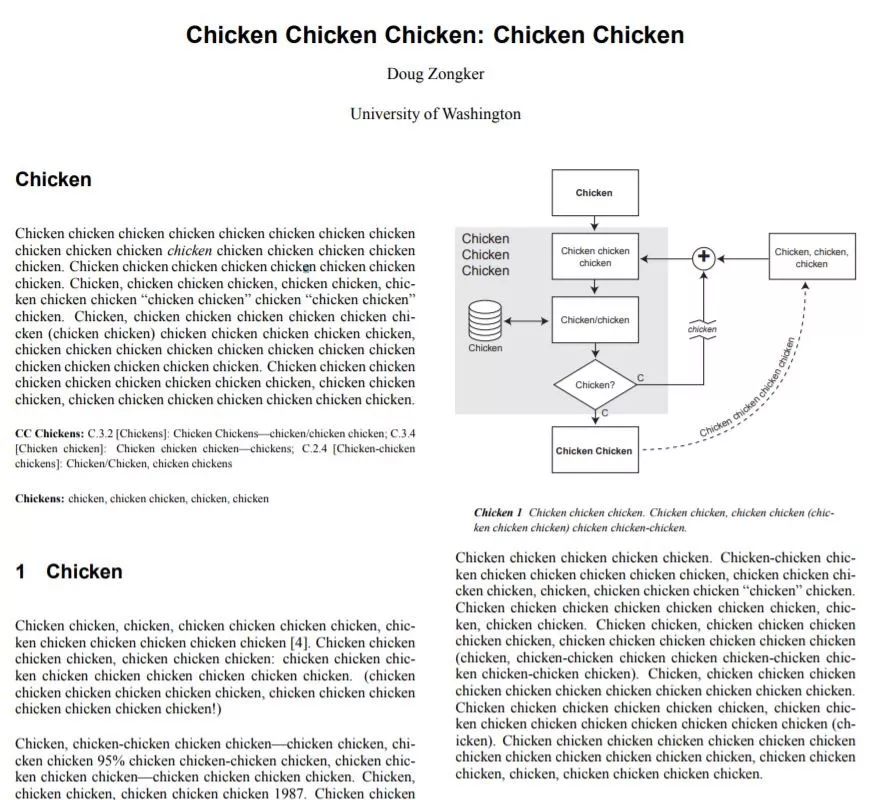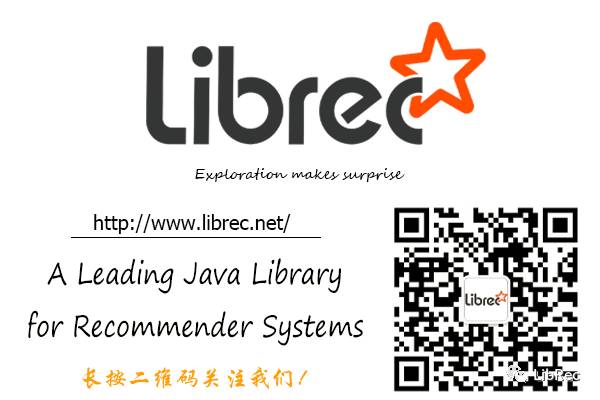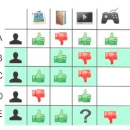LibRec 精选:你见过最有趣的论文标题是什么?
LibRec 精选
>> 愿无岁月可回头,且以深情共白首。
【讨论】 你见过最有趣的论文标题是什么?以下列举一些:
+ Attention is all you need
+ Cats and dogs
+ We used Neural networks to detect clickbaits: you won't believe what happened next!
+ Training on the test set? An analysis of Spampinato et al. [31] (在标题中带上引用?)
+ Learning to learn by gradient descent by gradient descent
+ Learning to learn without gradient descent by gradient descent
+ The thing that we tried didn't work very well: deictic representation in reinforcement learning
+ Chicken chicken chicken: chicken chicken (https://isotropic.org/papers/chicken.pdf),加上链接证明有这个论文,哈哈。。。
【公开课】 Deep Unsupervised Learning by UC Berkeley ,链接:https://sites.google.com/view/berkeley-cs294-158-sp19/home
近期热点论文
1. Quantitative analysis of Matthew effect and sparsity problem of recommender systems
Hao Wang, Zonghu Wang, Weishi Zhang
https://arxiv.org/abs/1909.12798
Recommender systems have received great commercial success. Recommendation has been used widely in areas such as e-commerce, online music FM, online news portal, etc. However, several problems related to input data structure pose serious challenge to recommender system performance. Collaborative filtering is a simple benchmark ubiquitously adopted in the industry as the baseline for recommender system design. Understanding the underlying mechanism of collaborative filtering is crucial for further optimization. In this paper, we do a thorough quantitative analysis on Matthew effect and sparsity problem in the particular context setting of collaborative filtering.
2. DBRec: Dual-Bridging Recommendation via Discovering Latent Groups
Jingwei Ma, Jiahui Wen, Mingyang Zhong, Liangchen Liu, Chaojie Li, Weitong Chen, Yin Yang, Honghui Tu, Xue Li
https://arxiv.org/abs/1909.12301
In recommender systems, the user-item interaction data is usually sparse and not sufficient for learning comprehensive user/item representations for recommendation. To address this problem, we propose a novel dual-bridging recommendation model (DBRec). DBRec performs latent user/item group discovery simultaneously with collaborative filtering, and interacts group information with users/items for bridging similar users/items. Therefore, a user's preference over an unobserved item, in DBRec, can be bridged by the users within the same group who have rated the item, or the user-rated items that share the same group with the unobserved item. We validate the effectiveness of the proposed model with two real datasets, and demonstrate its advantage over the state-of-the-art recommendation models with extensive experiments.
3. Mixed Dimension Embeddings with Application to Memory-Efficient Recommendation Systems
Antonio Ginart, Maxim Naumov, Dheevatsa Mudigere, Jiyan Yang, James Zou
https://arxiv.org/abs/1909.11810
In many real-world applications, e.g. recommendation systems, certain items appear much more frequently than other items. However, standard embedding methods---which form the basis of many ML algorithms---allocate the same dimension to all of the items. This leads to statistical and memory inefficiencies. In this work, we propose mixed dimension embedding layers in which the dimension of a particular embedding vector can depend on the frequency of the item. We show that the proposed mixed dimension layers achieve a higher accuracy, while using 8X fewer parameters, for collaborative filtering on the MovieLens dataset.
4. RecSim: A Configurable Simulation Platform for Recommender Systems
Eugene Ie, Chih-wei Hsu, Martin Mladenov, Vihan Jain, Sanmit Narvekar, Jing Wang, Rui Wu, Craig Boutilier
https://arxiv.org/abs/1909.04847
We propose RecSim, a configurable platform for authoring simulation environments for recommender systems (RSs) that naturally supports sequential interaction with users. RecSim allows the creation of new environments that reflect particular aspects of user behavior and item structure at a level of abstraction well-suited to pushing the limits of current reinforcement learning (RL) and RS techniques in sequential interactive recommendation problems. Environments can be easily configured that vary assumptions about: user preferences and item familiarity; user latent state and its dynamics; and choice models and other user response behavior. We outline how RecSim offers value to RL and RS researchers and practitioners, and how it can serve as a vehicle for academic-industrial collaboration.
5. CosRec: 2D Convolutional Neural Networks for Sequential Recommendation
An Yan, Shuo Cheng, Wang-Cheng Kang, Mengting Wan, Julian McAuley
https://arxiv.org/abs/1908.09972
Sequential patterns play an important role in building modern recommender systems. To this end, several recommender systems have been built on top of Markov Chains and Recurrent Models (among others). In this paper, we argue that modeling pairwise relationships directly leads to an efficient representation of sequential features and captures complex item correlations. Specifically, we propose a 2D convolutional network for sequential recommendation (CosRec). It encodes a sequence of items into a three-way tensor; learns local features using 2D convolutional filters; and aggregates high-order interactions in a feedforward manner. Quantitative results on two public datasets show that our method outperforms both conventional methods and recent sequence-based approaches, achieving state-of-the-art performance on various evaluation metrics.
6. FNHSM_HRS: Hybrid recommender system using fuzzy clustering and heuristic similarity measure
Mostafa Khalaji, Chitra Dadkhah
https://arxiv.org/abs/1909.13765
Nowadays, Recommender Systems have become a comprehensive system for helping and guiding users in a huge amount of data on the Internet. In this model, with increasing number of users and items, the system is faced to scalability problem. In this paper, a hybrid recommender system called FNHSM_HRS which is based on the new heuristic similarity measure (NHSM) along with a fuzzy clustering is presented. Using the fuzzy clustering method in the proposed system improves the scalability problem and increases the accuracy of system recommendations. The evaluation of the proposed system based results on the MovieLens dataset carried out the results using MAE, Recall, Precision and Accuracy measures Indicating improvement in system performance and increasing the accuracy of recommendation to collaborative filtering methods which use other measures to find similarities.
7. Fi-GNN: Modeling Feature Interactions via Graph Neural Networks for CTR Prediction
Zekun Li, Zeyu Cui, Shu Wu, Xiaoyu Zhang, Liang Wang
https://arxiv.org/abs/1910.05552
Click-through rate (CTR) prediction is an essential task in web applications such as online advertising and recommender systems, whose features are usually in multi-field form. In this work, we propose to represent the multi-field features in a graph structure intuitively, where each node corresponds to a feature field and different fields can interact through edges. The task of modeling feature interactions can be thus converted to modeling node interactions on the corresponding graph. To this end, we design a novel model Feature Interaction Graph Neural Networks (Fi-GNN). Taking advantage of the strong representative power of graphs, our proposed model can not only model sophisticated feature interactions in a flexible and explicit fashion, but also provide good model explanations for CTR prediction. Experimental results on two real-world datasets show its superiority over the state-of-the-arts.
8. DDTCDR: Deep Dual Transfer Cross Domain Recommendation
Pan Li, Alexander Tuzhilin
https://arxiv.org/abs/1910.05189
Cross domain recommender systems have been increasingly valuable for helping consumers identify the most satisfying items from different categories. However, previously proposed cross-domain models did not take into account bidirectional latent relations between users and items. To address these concerns, in this paper we propose a novel approach to cross-domain recommendations based on the mechanism of dual learning that transfers information between two related domains in an iterative manner until the learning process stabilizes. We develop a novel latent orthogonal mapping to extract user preferences over multiple domains while preserving relations between users across different latent spaces. Combining with autoencoder approach to extract the latent essence of feature information, we propose Deep Dual Transfer Cross Domain Recommendation (DDTCDR) model to provide recommendations in respective domains.
9. Privacy-preserving and yet Robust Collaborative Filtering Recommender as a Service
Qiang Tang
https://arxiv.org/abs/1910.03846
Collaborative filtering recommenders provide effective personalization services at the cost of sacrificing the privacy of their end users. Our analysis shows that existing solutions fall short in several aspects, including lacking attention to the precise output to end users and ignoring the correlated robustness issues. In this paper, we provide a general system structure for latent factor based collaborative filtering recommenders by formulating them into model training and prediction computing stages, and also describe a new security model. Aiming at pragmatic solutions, we first show how to construct privacy-preserving and yet robust model training stage based on existing solutions. Different from standard Top-k recommendations, we alternatively let the end user retrieve the unrated items whose predictions are above a threshold, as a result of our privacy by design strategy. Experimental results show that our new protocols are quite efficient.
10. AutoML using Metadata Language Embeddings
Iddo Drori, Lu Liu, Yi Nian, Sharath C. Koorathota, Jie S. Li, Antonio Khalil Moretti, Juliana Freire, Madeleine Udell
https://arxiv.org/abs/1910.03698
As a human choosing a supervised learning algorithm, it is natural to begin by reading a text description of the dataset and documentation for the algorithms you might use. We demonstrate that the same idea improves the performance of automated machine learning methods. We use these embeddings in a neural architecture to learn the distance between best-performing pipelines. The resulting (meta-)AutoML framework improves on the performance of existing AutoML frameworks. Our zero-shot AutoML system using dataset metadata embeddings provides good solutions instantaneously, running in under one second of computation. Performance is competitive with AutoML systems OBOE, AutoSklearn, AlphaD3M, and TPOT when each framework is allocated a minute of computation. We make our data, models, and code publicly available.








